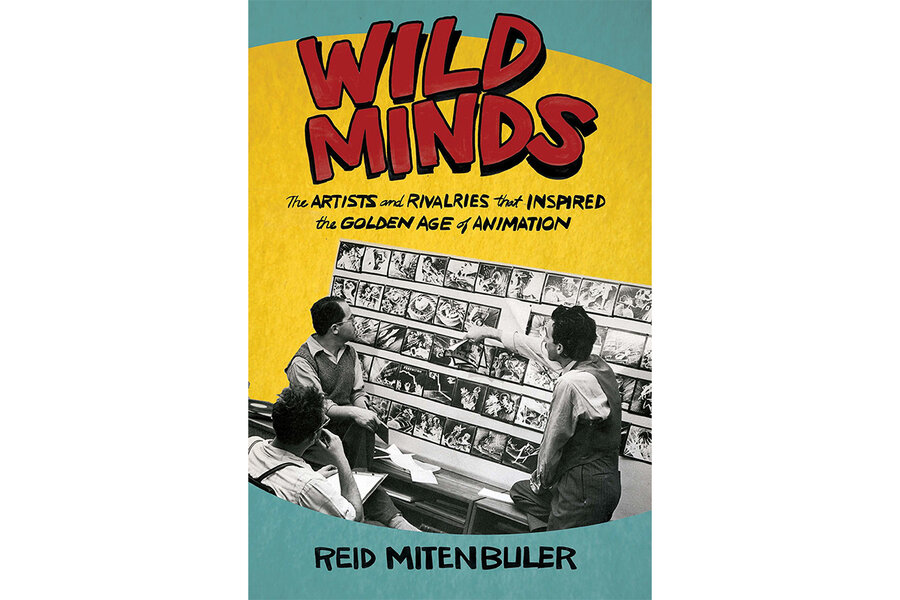‘Wild Minds’ explores the creative landscape of early animation
Loading...
Most people would identify Snow White, Grumpy, and Sleepy as cartoon characters, but it would have been a mistake to call them that within earshot of Walt Disney. Upon the release of his masterpiece “Snow White and the Seven Dwarfs” in 1937, Disney objected to a journalist describing his film as a “cartoon.” “It’s no more a cartoon,” Disney said, “than a painting by Whistler is a cartoon.”
In an exhaustive and highly entertaining new book, journalist Reid Mitenbuler demonstrates that he shares Disney’s belief in the artistic value of animated works – though they are, too often, thought of as mere kids’ stuff.
In “Wild Minds: The Artists and Rivalries That Inspired the Golden Age of Animation,” Mitenbuler goes wide and deep in surveying the talented, sometimes eccentric, and often irascible artists who developed, nurtured, and transformed the medium. Disney is among the book’s principal players, but to Mitenbuler’s credit, he never lets the big names completely dominate.
Non-animation buffs: Raise your hand if you’ve heard of animator Albert Hurter, one of the Disney artists who worked on “Snow White.” Famous or not, Hurter is given his due by Mitenbuler, who describes him as a “tall, gaunt, mustachioed man” who clocked in at 8 a.m. and out at 5 p.m. But between those hours, he was a creative force. “Before every new film, Hurter would allow his imagination free rein, then pass his sketches to the animators for inspiration,” Mitenbuler writes. “For Snow White he drew fifty to one hundred sketches a day.”
An early indicator of Mitenbuler’s masterful knowledge comes in the second chapter, where he dispels the widely held belief that Winsor McCay, best known as the writer-artist of the newspaper comic supplement “Little Nemo in Slumberland,” was the originator of the art of animation. Although McCay made hugely important contributions to the medium, including “Gertie the Dinosaur” in 1914, Mitenbuler notes that the first example of modern animated film seems to actually have been James Stuart Blackton’s “Humorous Phases of Funny Faces.” With a release date of 1906, it bests McCay’s earliest effort (an animated “Little Nemo”) by five years.
But Mitenbuler also identifies humanity’s seemingly instinctive desire to make drawings come to life throughout history, speculating that people once used flickering torches to suggest movement in cave drawings. Other antecedents to “Funny Faces” include everything from the shadow puppets of the Tang dynasty of China to the zoetrope invented in England in the 19th century.
The book follows animation’s evolution from a novelty to a bona fide industry. For example, Max Fleischer – who, along with his sibling Dave, are among the most creative filmmakers to ever work in the field – is accorded credit for coming up with the technique of rotoscoping. The technique, in which live-action photography is captured and then traced by animators, was a significant development that gave cartoons a patina of smoothness and professionalism.
Yet “Wild Minds” never gets bogged down in technical details. Mitenbuler keeps his eye on the ball, detailing the origin stories of a swath of beloved cartoon creations, from Betty Boop to Bugs Bunny. A gifted cultural historian, Mitenbuler devotes an entire chapter to an improbable court case in which a singer named Helen Kane claimed to have been the uncredited source of inspiration for Betty Boop, a trial in which the phrase “boop-boop-a-doop” became a major issue.
Without ignoring the horrid working conditions in which early animation staffs labored – one employee of the Fleischers was said to have become seriously ill and then died because of the dingy conditions at the studio – or the racist and sexist attitudes that were sadly prevalent, Mitenbuler praises the surprising degree of sophistication present in the major animated works of the period.
The rather ordinary title of the Fleischers’ “Betty Boop in Snow-White” (1933) does not begin to describe its surreal sights and soundtrack (including Cab Calloway performing “St. James Infirmary Blues”), and the brothers’ “Popeye” cartoons are, rather amazingly, said to have inspired the Abraham Lincoln Brigade in the Spanish Civil War. The brigade, Mitenbuler writes, “even adapted Popeye’s theme song into a battle cry, fitting new words to the familiar ‘I’m Popeye the Sailor Man!’”
Disney may look milquetoast next to the freewheeling spirit of the Fleischers. But while the legendary animation king’s aims were certainly more conservative, he broke tremendous amounts of ground in other areas. A fortune was poured into Disney’s “Snow White,” which, upon its release, was praised by Russian filmmaker Sergei Eisenstein as the greatest film, animated or otherwise, produced to that point.
The book also surveys the proudly anarchic animated efforts at Warner Bros., which included modeling Daffy Duck’s signature lisp on that of an unpopular studio executive, as well as the sleek, stylish offerings of United Productions of America (UPA), which sought to be the antithesis of both the sentimental Disney and the raucous Warner Bros. crew.
Whatever an animation fan’s taste, Mitenbuler’s book provides fascinating stories and nuggets. For the uninitiated, it certainly can aid in the formation of viewing lists to keep both children and adults occupied while riding out the pandemic.








